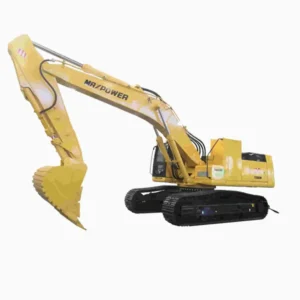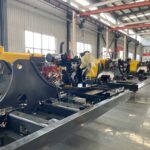Are you looking for a versatile and efficient piece of machinery to help with your construction or landscaping projects? Look no further than the wheeled mini excavator! This compact and agile machine is perfect for tackling jobs in tight spaces, but there are many more facts about it that nobody has told you yet. From different types to pros and cons, this blog post will provide you with all the information you need to know before making a decision on whether or not to invest in a wheeled mini excavator. So let’s dig into the details!
What is a Wheeled Mini Excavator?
A wheeled mini excavator is a small and versatile piece of machinery used for digging, excavation, demolition or landscaping tasks. It consists of a cab mounted on an undercarriage with wheels or tracks that provide mobility and stability in different terrains.
These machines are smaller than standard excavators but still pack a punch when it comes to power and performance. They are typically less than 6 metric tons in weight and can reach depths up to 3 meters. The compact size enables them to maneuver easily in tight spaces like urban construction sites or residential properties.
Wheeled mini excavators come equipped with various attachments such as buckets, hammers, augers or thumbs that allow them to handle multiple tasks efficiently. These attachments are interchangeable making the machine more flexible for use on different projects.
Operators can control the machine from within the cab where they have access to foot pedals, joysticks or levers that regulate speed, direction and hydraulic functions. This makes operating the equipment much easier compared to other heavy machinery like bulldozers or cranes.
In summary, wheeled mini excavators offer many benefits due to their compact size and versatility. They’re perfect for navigating tight spaces while performing various tasks using interchangeable attachments controlled by operators inside cabs via joysticks and pedals without having To worry about stability because of its wheels/tracks undercarriage.
The Different types of Wheeled Mini Excavators

Wheeled mini excavators come in different types, each with its unique features and capabilities. One of the most common types is the compact wheeled excavator, which is ideal for small-scale construction projects that require tight maneuverability in confined spaces.
Another type of wheeled mini excavator is the utility-class model, which has a broader range of applications than its compact counterpart. This type can handle more significant excavation jobs while still maintaining the agility required to work in confined spaces.
The third type of wheeled mini excavator is the zero-tail-swing (ZTS) model. With this machine, you can rotate 360 degrees without displacing any adjacent structures or objects. The ZTS design makes it an excellent choice for working on sites where space constraints are critical.
There’s also the hybrid electric-powered wheeled mini-excavator that offers a combination of gas and electric power sources to reduce fuel consumption and emissions compared to traditional machines. This eco-friendly option provides increased efficiency at a lower operating cost while reducing environmental impact.
When choosing between these options, it’s essential to consider your specific needs and budget carefully. Each machine has its strengths depending on project requirements such as size restrictions or energy usage preferences but all will get your job done efficiently!
The Pros and Cons of Wheeled Mini Excavators
Wheeled Mini Excavators are versatile machines that can handle a variety of tasks in tight spaces. However, like any piece of equipment, they have their pros and cons.
Pros:
One key advantage of wheeled mini excavators is their mobility. Their compact size makes them easy to transport to different job sites, and the wheels allow for quick movement around the site itself.
Another benefit is their versatility. They can be outfitted with various attachments such as buckets, hammers, or augers depending on the task at hand.
Wheeled mini excavators also tend to have lower operating costs compared to larger models due to their smaller size and reduced fuel consumption.
Cons:
While they may be able to tackle most jobs in tight spaces, larger projects may require more powerful equipment.
The small size means that they typically have less digging depth and reach than larger models.
Additionally, while wheels provide great mobility on flat surfaces like pavement or concrete, tracks may be necessary for rougher terrain or steep inclines.
Wheeled mini excavators are great machines for certain types of jobs but it’s important to consider both their advantages and limitations before deciding if one is right for your project.
How to Use a Wheeled Mini Excavator?
Using a wheeled mini excavator can be intimidating for first-timers, but with proper knowledge and training, it can be an efficient machine for various tasks. Here are some tips on how to use a wheeled mini excavator:
1. Familiarize yourself with the controls – Before operating the machine, make sure you understand all the controls and their functions.
2. Check the surroundings – Ensure that there are no obstacles or uneven terrain around your work area that could cause accidents or damage to the equipment.
3. Start slow – Begin by testing out small movements to get comfortable with the machine’s operation before moving on to more complex tasks.
4. Use proper digging techniques – When digging, always start from one corner and work your way across in orderly rows to avoid accidentally damaging pipes or cables buried underground.
5. Maintain regular upkeep – Regular maintenance is necessary for optimal performance of your wheeled mini excavator, so make sure you follow manufacturer guidelines on oil changes and other routine maintenance checks.
By following these simple steps and always prioritizing safety measures when using a wheeled mini excavator, you’ll be well-equipped to handle any job thrown your way!
When to Use a Wheeled Mini Excavator?

When it comes to construction projects, choosing the right equipment is crucial. One versatile and compact option that can handle a variety of tasks is the wheeled mini excavator. So when should you use one?
Firstly, if your project involves working in tight spaces or areas with limited access, such as urban sites or residential properties with small backyards, a wheeled mini excavator may be ideal. Its compact size allows for easy maneuverability in confined spaces.
Secondly, if you need to complete digging or excavation work quickly and efficiently, a wheeled mini excavator can get the job done. With its powerful hydraulic system and various attachments available (such as buckets and hammers), it can tackle various soil types and dig through tough materials like concrete.
Thirdly, if your project requires versatility and mobility between different job sites, a wheeled mini excavator’s portability makes it an excellent choice. This machine is easy to transport from one location to another on a trailer without requiring special permits.
There are many scenarios where using a wheeled mini excavator could benefit your construction project – particularly those with space constraints or tight deadlines. Always consider factors such as site accessibility before deciding which type of equipment will best meet your needs!
Alternatives to the Wheeled Mini Excavator
While wheeled mini excavators offer several benefits, they may not be the best choice for every project. Fortunately, there are alternatives that can get the job done efficiently and effectively.
One option is a skid steer loader. These machines are versatile and can handle a variety of tasks, including digging, grading, and hauling materials. They also have excellent maneuverability in tight spaces.
Another alternative is a backhoe loader. This machine combines the capabilities of a tractor with those of an excavator or front-end loader. It offers excellent digging power and versatility on construction sites.
For smaller jobs, hand tools such as shovels or picks may suffice. While these require more manual labor than mechanical equipment, they are often more cost-effective for small projects.
Ultimately, choosing the right tool for the job depends on factors such as budget, project size and scope, terrain conditions and time constraints. By weighing all options carefully before making a decision you will ensure that your project is completed successfully while minimizing costs and maximizing efficiency.
Conclusion
To sum it up, wheeled mini excavators are an excellent investment for those who need to do landscaping and construction work. These machines can easily move around tight spaces while still offering the power necessary to complete various tasks.
It’s essential to keep in mind that each type of wheeled mini excavator has its strengths and weaknesses. Some may be better suited for specific jobs than others, so it’s crucial to do your research before purchasing or renting one.
Additionally, using a wheeled mini excavator requires careful planning and attention to safety measures. Always make sure you’re following the manufacturer’s instructions and taking all necessary precautions.
If you have a project that requires digging or moving materials in tight spaces, a wheeled mini excavator is definitely worth considering. With proper use and maintenance, these machines can help make your work faster, safer, and more efficient.







-150x150.webp)
